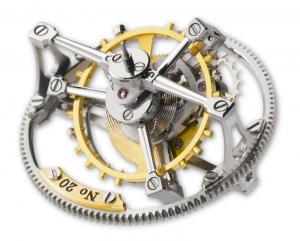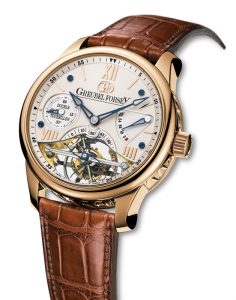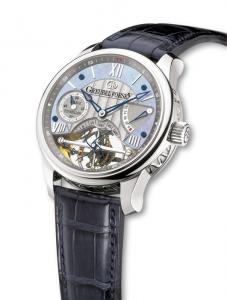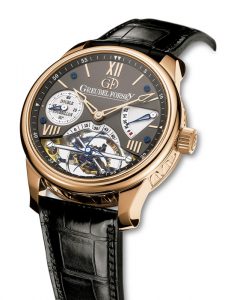GREUBEL FORSEY Double Tourbillon 30°
From the pocket to the wrist…
200 years earlier
“Give me the perfect oil, and I will give you the perfect watch,” said Abraham Louis Breguet, the watchmaker from Neuchâtel who invented the Tourbillon regulator and who lived in Par is dur ing the Age of Enlightenment.
Two centuries later and 50 years after the adaptation of his ingenious mechanism to a wristwatch, it is estimated that several thousand Tourbillon watches have been produced, all of them aimed at eliminating the equilibrium defect of the balance and spring caused by the pull of the earth’s gravity.
Whilst the Tourbillon pocket watches made their mark as chronometers during the years 1850-1880, thanks to its appearance in the wristwatch the device has remained one of the most prestigious complications of haute horlogerie.
The first Tourbillon created for the wrist
However, with the passage of time it became essential to give a new impetus to the Tourbillon, to take a major step forward by adapting it specifically to the wristwatch whilst adhering to its principal features.
Moving beyond existing achievements
The watchmaker-inventors Robert Greubel and Stephen Forsey, based in their atelier in La Chaux-de-Fonds, wished to surpass the accomplishments of existing movements by plunging deeper into the subject and inventing a Tourbillon which significantly improves the functioning of a wristwatch.
After four years of effort, they created a Tourbillon within a tourbillon, in such a way that this new complication permanently compensates the gravity-related errors of rate in all wristwatch positions.
Named the Double Tourbillon 30°, due to the angle that links the two mobile cages, the patented double Tourbillon system is a decisive technical advance and a milestone in watchmaking history.
Eliminating the flaw in equilibrium…
A revolution within a revolution
Inside an exterior Tourbillon with a diameter of around 15mm which turns in a four-minute period, an interior Tourbillon, smaller in size and inclined at 30 degrees in relation to the first cage, revolves in 60 seconds.
It contains the escapement, free sprung balance system with flat hairspring and Phillips terminal curve. A mark of its sophistication is the two cages which comprise 128 elements and altogether weigh a mere 1.17 grams.
The main characteristic of the invention, that is the 30-degree inclination of the interior cage rotation axis in relation to the rotational speed of the two Tourbillon cages, create the optimal conditions for the balance wheel to oscillate permanently in all positions: the compensation of the differences in rate due to the earth’s gravity pull is no longer limited to the vertical position.
Optimal chronometric performance
The choice of 30 degrees for the angle between the two turning carriages ensures a better chronometric performance whilst maintaining a perfectly acceptable depth to the watch. Furthermore, the exterior Tourbillon’s rapid rotational speed of four minutes gives ideal mobility to the balance wheel by avoiding prolonged exposure to the earth’s gravitational pull in less favourable positions of the watch. A simple test of proof: try to place the balance wheel in a horizontal position and you will find it is simply impossible to do so! The Double Tourbillon 30° is driven by twin barrels geared in line, one of which is equipped with a slipping spring so as to avoid any defect caused by excess tension on the mechanisms during winding. It has a power reserve of at least three days, ie 72 hours.
High-performance gearing
A conical gearing, composed of a wheel and a pinion, with profiled teeth specifically made for the Double Tourbillon 30°, was chosen so as to enable an improved power transmission, superior to that of classical solutions.
The architecture of this movement within a diameter of 36.4mm is entirely dedicated to the presentation of the Double Tourbillon 30°. Its unconventional construction uses two plates so as to organise the gear-trains and bridges in discrete fashion, leaving space for the rotation of the imposing cages. The plates and bridges are made of solid nickel silver, a traditional watchmaking alloy (copper, zinc and nickel), used in production of small, very high quality series, with a “jade gold” finish exclusively reserved for Greubel Forsey. The bridges are decorated with a subtle graining and the plates are finely circled so as to enhance the movement. The domed and olived jewels are fitted into gold chatons.





